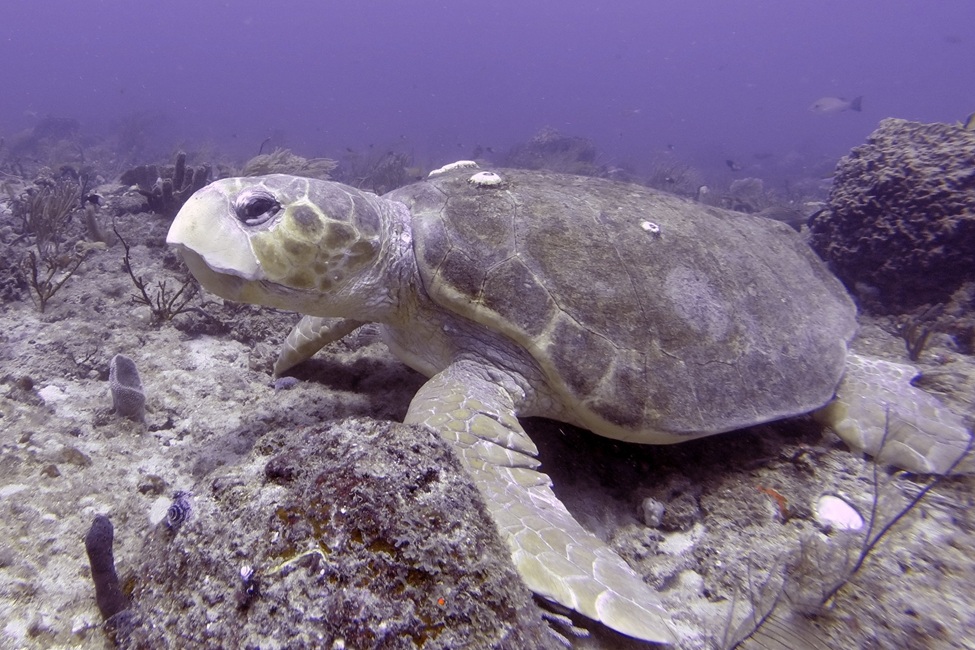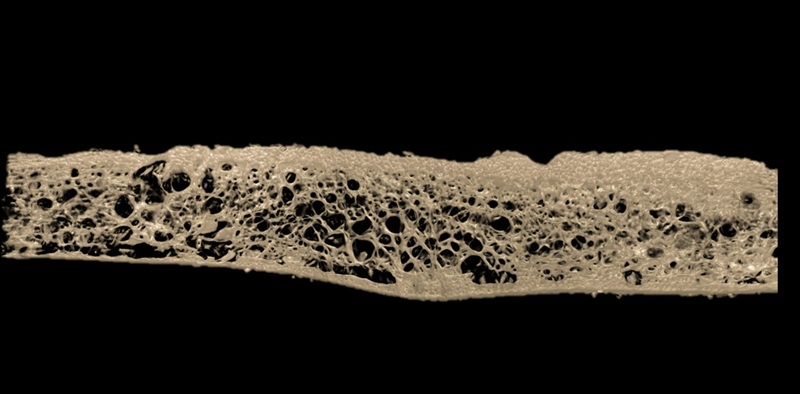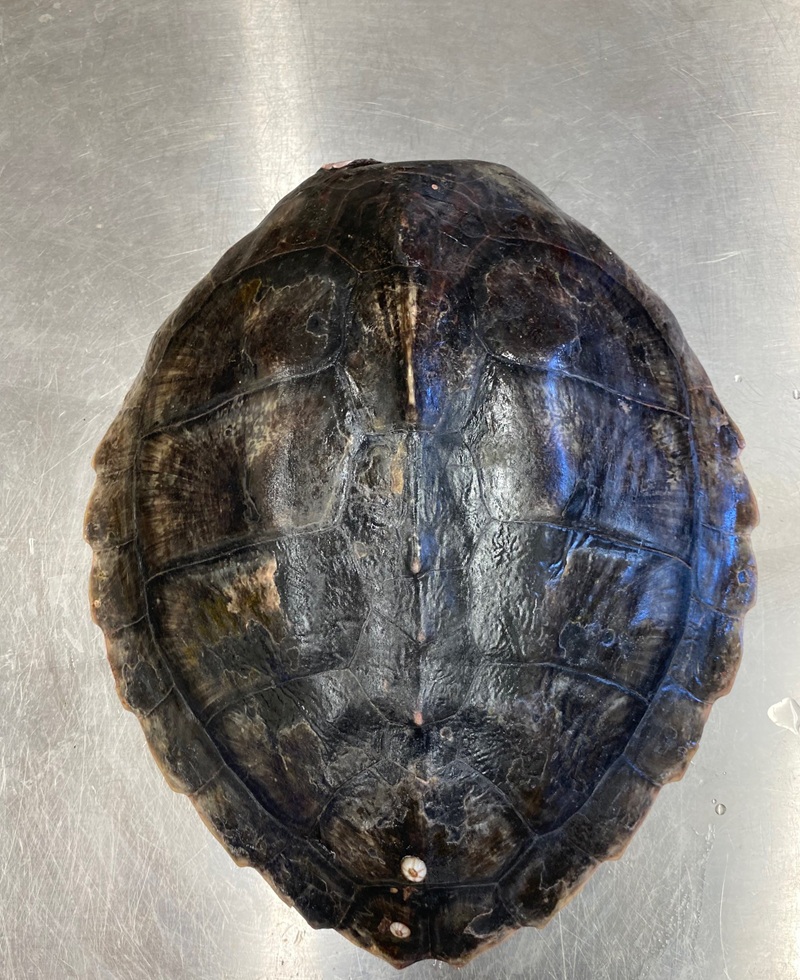'Flex Appeal:' Balancing Armor and Efficiency in Sea Turtle Shells

An adult loggerhead (Caretta caretta) sea turtle, one of the three species explored in the study.
When we picture sea turtles in the wild, it’s easy to envision them as armored warriors – their hard, resilient shells serving as near-impenetrable shields against oceanic threats like sharks. These sleek, streamlined shells aren’t just defensive – they’re engineered for speed, efficiency and survival. Designed to minimize drag, they allow sea turtles to glide effortlessly through the water, dive to astonishing depths, and handle the immense pressure shifts as they surface.
A sea turtle’s shell is a complex masterpiece, made up of two parts: the carapace (top) and the plastron (bottom), both covered in scutes – tough keratin plates tightly attached to the bone. The bone forms a unique “sandwich” of dense outer bone and a lightweight, spongy core, combining strength, buoyancy and protection for the turtle’s muscles, nerves and vital organs.
But what is it about these material properties that give marine turtles’ shells such remarkable protection and agility? While much has been studied about the shells of freshwater turtles and land tortoises, marine turtles have received comparatively little attention.
To fill this gap, researchers from Florida Atlantic University dove deep into the biomechanical properties of the carapaces of three common sea turtle species from the North Atlantic: green turtles (Chelonia mydas), loggerheads (Caretta caretta) and Kemp’s ridleys (Lepidochelys kempii). Their findings have revealed surprising new insights into the development of these ocean-dwelling titans.
Using advanced compression tests and statistical models, the team examined the toughness, stiffness and strength of these turtles’ shells across many stages of life – from juveniles to adults.
Their results, published in the Journal of Experimental Biology, show that the shell bone complex of marine turtles plays a crucial role in balancing biomechanical trade-offs such as lower stiffness and a high degree of flexibility to protect them against predators and environmental stressors while also optimizing their ability to move efficiently through water. This unique adaptation highlights the complex and dynamic nature of marine turtle morphology, where the shell’s design must accommodate the demands of both survival and efficient locomotion in their aquatic habitats.
Although all three species share a similar structural design, they each display striking differences in how their shells respond to stress. Green turtles, for instance, boast the toughest, stiffest shells, with denser, stronger bones. Meanwhile, loggerheads have more flexible, porous carapaces, a design that is more compliant under pressure. These variations likely reflect each species’ evolutionary response to their unique environments and the threats they face.
Interestingly, the toughness of a turtle’s shell remains constant as it grows within each species.
“We believe this variation is likely a result of their evolution and the environments they inhabit,” said Ivana J. Lezcano, first author and doctoral student in the FAU Department of Biological Sciences within the Charles E. Schmidt College of Science. “The differences in shell stiffness across these species may be connected to their distinct life histories, with each species adapting to unique environmental challenges and predation risks.”
For both green turtles and Kemp’s ridleys, their shells become even stiffer and stronger as they grow larger, offering greater defense – especially as subadults and adults. Kemp’s ridleys, in particular, experience a faster increase in shell stiffness as they grow, possibly because they mature earlier and shift to foraging in riskier coastal waters.
“What’s fascinating is that their shells evolve to provide more protection over time,” said Lezcano. “The stiffness of juvenile green turtle shells may be especially important because their shells lack the protective spines and keels, which young loggerheads and ridleys sport to armor themselves against predators. It’s a dynamic interplay of form and function that ensures these turtles are built for survival.”
Loggerheads, however, didn’t show a significant change in shell stiffness across life stages. This slower development in shell stiffness could explain why they stay in the open ocean for a longer period, avoiding the more dangerous coastal habitats until they are larger and better protected.
Researchers also discovered that marine turtles’ shells respond to compression in a similar way to those of land turtles, which have a similar basic shell structure. The shell’s internal porous layer is key to its strength, allowing it to be both stiff and tough, which helps protect turtles from attacks like biting or clawing.
“The shells of adult sea turtles are surprisingly compliant compared to their land relatives,” said Jeanette Wyneken, Ph.D., co-author and a professor of biological sciences, FAU Charles E. Schmidt College of Science. “But here’s the cool part: while their shells become stronger over time, they don’t become completely rigid like the shells of land turtles. This flexibility is key – because it enables them to ‘flex the shell’ under pressure, which is crucial for navigating the harsh and varying conditions of underwater environments.”
This study not only uncovers the fascinating design of sea turtle shells but also reveals how nature has intricately fine-tuned these creatures for survival.
“Our study provides new insights into why sea turtles have thrived over time,” said Marianne Porter, Ph.D., co-author and an associate professor in the FAU Department of Biological Sciences. “Their shells are adapted to their aquatic lifestyle, and stiff enough to defend against predators while being tough enough to absorb shock. This remarkable balance of strength and flexibility has allowed them to survive in the ocean for millions of years – an example of evolution shaping species in an environment.”
 A CT cross-section of a piece of shell showing the dense outer and porous inner bone.
A CT cross-section of a piece of shell showing the dense outer and porous inner bone.
 The sea turtle shell of a juvenile Kemp’s Ridley.
The sea turtle shell of a juvenile Kemp’s Ridley.
-FAU-
Latest News Desk
- The Runway at Florida Atlantic Announces 15th Venture ClassThe Runway at Florida Atlantic recently accepted 17 companies to participate in the 15th cohort of its Venture Program.
- FAU Receives Gift for Marta and Jim Batmasian Memorial PavilionFAU has announced a $500,000 gift from benefactors Marta and Jim Batmasian to name the Marta and Jim Batmasian Memorial Pavilion for the future Kurt and Marilyn Wallach Holocaust and Jewish Studies Building.
- FAU CARD Releases Free Water Safety Guide for Children with AutismDrowning is the top cause of unintentional death for children aged 1 to 4 in Florida, and autism increases the risk. FAU's CARD is offering a free guide to help protect children with autism from drowning.
- Fewer Parasites in Indian River Lagoon Signal Big Ecosystem ProblemsFAU Harbor Branch researchers used parasite data to assess the ecological health of Florida's Indian River Lagoon, which has suffered from pollution and algal blooms, damaging habitats like seagrass beds.
- From Students to Physicians: FAU Celebrates Graduating Class of 2025The Charles E. Schmidt College of Medicine celebrated the nation's newest physicians and biomedical researchers during its commencement ceremony today at the Carole and Barry Kaye Auditorium.
- FAU's Innovation Awards Celebrate Ingenuity, EntrepreneurshipFlorida Atlantic University's recent Innovation Awards awarded more than $55,000 in prizes across four innovation and entrepreneurship competitions.






